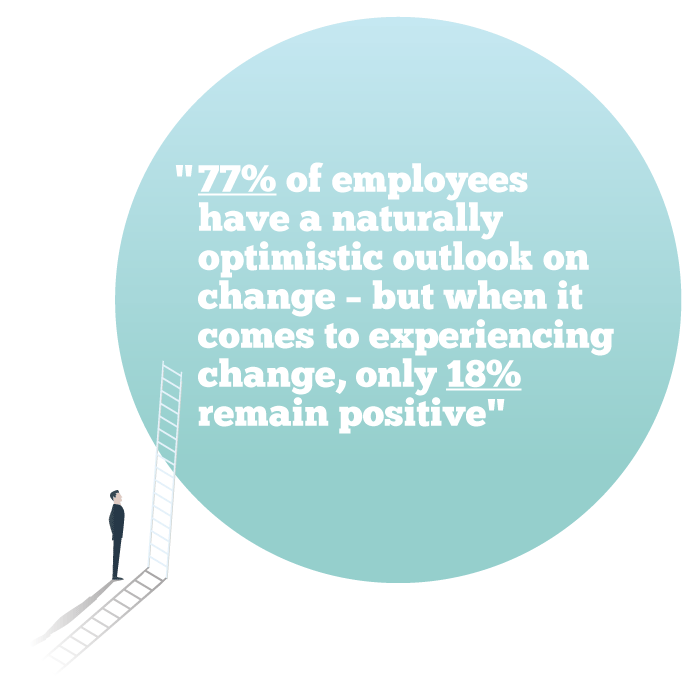
2017 was a landmark – and exciting – year for internal communications.
Particular highlights for us were CIPR Inside’s revelatory research project ‘Making It Count’, which revealed that senior leaders are finally switching on to the true potential of IC as a key strategic enabler (see what we got up to at their accompanying conference in November), and the release of a certain infamous Cosmopolitan article, which brought internal communicators together to (loudly quash its damaging – and let’s be honest, entirely untrue – assertions about the industry.
It was delightful to see the voices of internal comms professionals finally being unleashed in full force in 2017. And we can’t wait to hear them getting even louder over the course of 2018.
However, as much as we’d like to say that 2017 was all roses for internal comms – it was not without its challenges.
Here at H&H we’ve pored over more than 20 important industry research studies carried out in 2017, to get a crystal-clear view of where internal comms stands as we head into 2018.
And what it tells us is, there’s still plenty to do.
Based on what we’ve discovered, we’ve highlighted the top 7 internal comms challenges for IC professionals to focus on in 2018, as well as tips on how to resolve them – so we can all get our priorities in order. And build upon the great successes achieved in 2017. We wonder – which will you be focusing on over the year ahead?
Got your headsets on and birthday cakes at the ready? (just kidding). Here we go…
Internal comms 2018 challenge 1:
Work with senior leaders to better articulate and communicate vision and direction
The political tidal waves that crashed onto the global scene in 2016 resonated prominently into 2017 and don’t look set to calm in 2018. Brexit looms large over the UK economy, and the rise of populism in Europe has cast a spectral shadow towards an uncertain future.
And it’s taking its toll on employees. The Edelman Trust Barometer rates current global trust in CEOs at just 43% (although this is an improvement on last year’s all-time-low rating of 37%). If ever there was a time for Visible Felt Leadership, it’s now – and the research tells us that senior leaders have overtaken managers in importance when it comes to reassuring, inspiring, and engaging the bottom line.
The trouble is, they’re falling scarily short of the mark. Only 15% of employees strongly agree that their senior leaders make them enthusiastic about the future. And 44% don’t feel they’re providing clear direction. This is IC’s chance to prove its worth. It’s an opportunity for the industry to truly come into its own. So what can internal comms professionals do about this challenge?


So what can internal comms professionals do about this challenge?
In 2018, internal communicators need to help senior leaders to more clearly articulate vision, direction, and values. They need to lend their communications expertise to cascade them compellingly through the organisation. And they need to act as employees’ advocates, making their voices heard and providing open and honest reassurance and guidance.
Internal comms 2018 challenge 2:
Improve manager communication
Once again, manager communication is proving a particularly irksome challenge within internal comms. It’s a problem which IC professionals can’t seem to overcome – snagging the top spot of the priority list seemingly every year.
It’s quite shocking that as many as 69% of managers feel uncomfortable communicating with employees in general – never mind on organisational matters. And the second-largest workforce generation – the Millennials – aren’t any more optimistic, with only 17% regarding the feedback they receive from their managers as genuinely valuable.
As this generation usurps the Boomers and we prepare for the influx of their successors the Gen Z’ers, manager communication will become more business-critical than ever. The younger generations want communication on a much more regular basis – meaning there’s absolutely no time to drag our feet.


So how can internal comms professionals help?
Internal communicators need to work with managers to ensure they have the right skills and know-how to communicate with every employee. Whether that’s through cascade packs, workshops, or simply giving them the right tools to hold their own productive conversations with their teams.
It’s also important to listen to managers as well. Why might they be struggling to communicate? What knowledge gaps are present? How could they be given the confidence to communicate with conviction? Once you have the answers to these questions, you’ll stand a better chance of helping them bring their communication A game.
Try our handy Conversation Cards to initiate revealing and engaging conversations with your employees:


Internal comms 2018 challenge 3:
Deepen employees’ connection with organisational purpose
Any internal comms practitioner worth their salt will know that an employee’s connection with their organisation’s purpose is vital to their level of engagement.
The organisation’s purpose is a rally cry, a call-to-arms – a statement of what it stands for, what it’s out to achieve, and how it aims to make a difference to people’s lives.
And psychology dictates that we humans crave a fundamental purpose of our own, which drives us towards an ultimate goal or achievement. So when our own values and beliefs chime with those of our organisation, it inspires us to go above and beyond. Likewise, we’re sure you’ll be familiar with the empty feeling which comes with a lack of it – when you just can’t seem to connect with your role, no matter how hard you try.
Read more: Cracking the code: why organisational values are essential to the employee experience
Connecting employees with their organisation’s purpose gives them the energy, devotion and vitality to deliver great results. In fact, last year it was revealed that a strong connection with organisational purpose has some surprising additional benefits – an 8.1% decrease in turnover, a 4.4% increase in profitability, and even a 12.7% reduction in safety incidents. Who knew?


But once again – spot the theme – the reality isn’t living up to the ideal. Just 40% of internal comms professionals believe that employees understand ‘well’ or ‘very well’ the contribution they’re making to their organisation’s strategy. Meaning that 60% think that employees are effectively working lost and blind, lacking that deeper connection with their organisation’s direction.
So how can we help make these connections stronger?
If the organisation’s purpose, mission and values are fuzzy, find a clear and compelling way to articulate them, and a creative, inspiring means of cascading them down to the bottom line. This doesn’t necessarily mean reimagining them – just making sure they’re understood across the organisation.
But if it’s a more personal problem on the part of the employee, talk to them. Get to the heart of why they might be feeling unfulfilled at work – and help to put the necessary steps in place to resolve the issue.
Internal comms 2018 challenge 4:
Help senior leaders to address the impending Employee Experience challenge
Move over employee engagement – there’s a new kid on the block.
Just as those at the top were beginning to master the problem of engagement, the issue of the ‘Employee Experience’ has risen promptly out of its shadow – and represents a whole new challenge for senior leaders.
Employee engagement vs the employee experience
But what exactly is the difference between employee engagement, and the employee experience? Well actually, not very much – they’re remarkably similar. However, whereas employee engagement zones in on an employee’s emotional response – ie. assessing their level of fulfilment, their satisfaction, and their sense of connection with the organisation – the employee experience takes a more holistic approach, constituting the sum of all the employee’s interactions with and experiences within their workplace.
If we trace the macro development of the economy and labour force over recent years, the shift of focus from engagement to experience is wholly understandable. Employee engagement has its origins in the productivity crisis of the economic crash in 2007 – spawning a deeper focus on an employee’s engagement with and commitment to their work to increase output.


On the flip side, the emphasis on the employee experience has only recently become prominent, parallel with the onset of the war for talent. Employees want purpose and fulfilment from their organisation – and employers are having to step up their game to meet their changing needs. Work is no longer just a job. It has to be an experience.
The meat and potatoes of the employee experience are largely the same as those for good engagement. But it’s proving a particularly tough challenge for leaders to get to grips with.
Worryingly, research suggests that the majority of leaders aren’t yet prepared to address it – meaning the possibility of creating the perfect employee experience is well out of reach for most.
So how can internal communicators help senior leaders to overcome the employee experience challenge?
This is a challenge to which internal comms professionals are best placed to lend a hand. We need to share our expertise in what makes a truly engaged employee with the C-Suite, debating strategies for engagement and reaffirming the importance of consistent communication and building a strong culture.
But we also need to enter the fray. Reaching out to the bottom line for their views and opinions. Asking them what they want from the organisation. And feeding this information back up the ladder to the leadership. First-hand insights are invaluable when it comes to creating a culture that employees really love.
Discover what really makes an engaged employee in our ‘Anatomy of Employee Engagement’ IC Field Guide!


Internal comms 2018 challenge 5:
Reassess how we communicate change
In 2017, here at H&H we undertook a detailed, expansive study into how change is communicated and managed in organisations. And our results were particularly revealing.
First off, the good news. We came across a slice of humble pie for the notion of change resistance – that, contrary to popular belief, as many as 77% of employees actually have a naturally optimistic outlook on change.
But this optimism dies out pretty quickly. When it comes to experiencing and going through change – only 18% remain positive, while half feel mostly pessimistic. So what’s going on?


The findings from our research point to some core issues with the ways in which we have been communicating and managing change over the years, which are seriously damaging the chances of success.
We found that during change, 21% of employees feel they’re kept in the dark, 31% think the focus is more on the process than the people, and 47% feel unimportant and undervalued. Perhaps the infamous ‘70%’ statistic has some grounding to it after all…
So how can IC practitioners go about changing change in 2018?
These statistics highlight some key areas of focus for internal communicators when it comes to managing change. Ensuring that employees are centre stage when planning change programmes, that change communications are clear, consistent, and enlightening, and most crucially – that people feel that their thoughts and opinions matter. After all, aren’t the most important voices those of the people who’ll be most affected?
We’ll leave the rest to our ‘Changing Perspectives of Change’ IC Field Guide. It contains even more of the surprising results and statistics we discovered during our research. You can download it here – who knows, perhaps it will change the way you think about change communications forever…


Internal comms 2018 challenge 6:
Continue our progress on raising IC’s reputation and profile – and set the record straight on resources and budget
As we’ve already discussed, 2017 was a year of resounding success for internal comms. It’s truly delightful that three quarters of internal comms professionals now believe that IC is seen as a key driver of employee engagement by senior leaders. And even more so that 77% feel that CEOs and MDs now properly value it as a function.
See what industry peers are thinking in our blog: What does an internal communicator actually do? 12 internal comms professionals have their say
But while we’ve boldly lit the fire, it’s still burning decidedly softly when it comes to allocated IC resources and budgets. The frugality internal communicators have become accustomed to looks sadly set to continue into 2018.


Less than half (49%) of internal comms practitioners agree that they have access to the tools and resources they need to develop high-quality internal communications, and only 35% say that they’re afforded the budget necessary to develop and implement an effective internal comms strategy.
With new digital tools revolutionising the communications landscape and the ever-changing behaviours of employees, internal communicators have their work cut out to keep up with the ebb and flow of industry change. This is made significantly harder when they’re working on a shoestring.
So how we build on the success of 2017, and propel internal comms’ reputation to even greater heights in 2018?
Hopefully, the renewed emphasis on internal comms as an invaluable function will lead to a much-needed rise in budget and resource allocation this year. But if it still fails to appear, IC folk need to raise their voices louder, and lay out the repercussions that may be felt if quality internal comms are laid on the line off the back of insufficient resource.
We’re under more pressure than ever to live up to the expectations of those at the top – so budgets and resources must become the year’s hot topics if we’re to see success.
Internal comms 2018 challenge 7:
Become the masters of turning lots into less, and complex into simple
This is a key skill that internal communicators need to have tucked up their expert sleeve. It’s something that we here at H&H do all the time for our clients. In fact, it forms a key backbone of our culture. (Learn more about our winning culture here).
Our fundamental aim as internal communicators is to connect people with the messages that make their organisations go round. Whether that’s purpose, mission and values, a change programme, updates and news, or just sharing inspiring stories, it relies on extracting the core nuggets of inspiration that really matter, and communicating them in a clear, focused way.
Employees simply haven’t got the time in their busy schedules to trawl through reams and reams of copy. In the spirit of our time, they want instant, compelling messages – fast.


So for internal communications to have the greatest impact, they need to be short and snappy, but packed with powerful messages that inspire action.
This is something that can take practice to master, as data from 2017 shows. According to 35% of employees, their organisation’s important information gets buried by too much unnecessary detail being included in internal comms campaigns. And 1 in 5 do not feel fully informed about company news.
So how can internal comms professionals master this critical skill in 2018?
Evidently, some employees are missing out on crucial information – whether that’s because it’s invisible, or just not being communicated.
So internal comms practitioners must master the skill of finding the key messages within the deluges of information – making lots into less, and complex into simple. Ensuring that employees are really hearing what they need to hear.
If you’re an internal comms professional who wants to hone this critical skill, email us at talktous@handhcomms.co.uk and we’ll send you some of our very best Case Studies, so you can see exactly how we achieved the exceptional results we have for clients across the globe!
Clearly, internal communicators everywhere have got their plates full as they head towards the unknown horizons of 2018.
But if we focus on these key internal comms challenges over the year ahead, we’re sure we can make the progress needed to tick them off the IC bucket list for good – and make 2018 an even better year for the industry.
Are you up for it?
Before you go, we’ve got a gift for you…
We’ve only touched on a handful of the internal comms stats and facts that were unveiled in 2017 in this blog. We’ve collected plenty more surprising and revealing insights in our ‘Internal Comms & Employee Engagement: 2017 Year in Review’ IC Field Guide. Download it here to get the lowdown on where the industry now stands, as we prepare for whatever 2018 will throw our way.


Or if you’re old-fashioned and would like a printed version instead, just drop us a line and we’ll fire up our trusty homing pigeon!
Our IC Field Guides are great resources to share with colleagues, so why not spread the knowledge?







